Every weeknight it’s the same, all across the country: Local news anchors sign off with varying degrees of schmaltz … there’s a couple of commercials for cars or beer … and then it hits—the explosion of jubilant horns, grooving bass lines, tight guitar riffs, and funky keyboard blasts.
It’s late-night talk show time! Time for acerbic monologues, silly sketches, musical guests from all over the stylistic map, and interviews with stars and others getting their proverbial 15 minutes. But if you don’t watch closely—if you’re tucking the kids in or taking one last pass through your Facebook news feed—you might miss the people pumping out those catchy jams. Every night, no matter which network or cable channel you’re watching, a five-second pan across the stage is all the time you get to see some of the most talented, hardest-working musicians on TV. The gig comes with a perplexing dichotomy of fame and anonymity—go on, see for yourself: You know the shows and their hosts practically like they were your next-door neighbor, but how many of the 13 guitarists and bassists on these pages can you name without looking?
But don’t go feeling bad for them just yet. Although these guys groove away night after night on the world’s tiniest stages for audiences of millions who barely notice they exist, there are plenty of perks—40+ weeks of steady work each year playing a wide variety of music with a guaranteed paycheck, no late nights or early mornings, no heavy gear schlepping, and no shyster club owners or record label sleaze. Oh, and then there are the countless opportunities to meet and jam with a who’s-who of musical guests. “The best thing about this job is being excited every Sunday, knowing I get to go to work tomorrow!” says Letterman’s Sid McGinnis. He’s been at it for almost 30 years, and as we recently found out, his sentiment is shared by all the players of late-night TV.
We visited New York City and Los Angeles to interview the guitarists and bassists for six major talk shows, on set and in their rehearsal rooms, to find out what it’s really like to be part of a TV band.
The L.A. Crew: (left to right) The Tonight Show with Jay Leno's Paul Jackson Jr., Rickey Minor, and Dave Delhomme. Conan's Jimmy Vivino and Mike Merritt. Jimmy Kimmel Live!'s Toshi Yanagi and Jimmy Earl. Illustration by Steve Worthington.
It’s Showtime!
It’s mid-morning, and on both coasts the
guitarists and bassists who provide the
soundtrack to America’s late-night shows
are arriving at their respective television
studios. Most follow a similar schedule on
show day, beginning with a band meeting
somewhere between 10 a.m. and 1
p.m., depending upon the show. During
the meetings, the bands plan out the day’s
music—including commercial bumps (what
plays when the show goes into and comes
out of a commercial), play-on music (what
plays when a guest walks out), and music
for skits—at the direction of the band leader
or musical director. After the day’s tasks
are set, it’s time to rehearse and record.
All the music you hear during the show is played by the band, and the music used during prerecorded sketches or offsite bits is usually recorded in the hours preceding the taping of the main show. “We move pretty fast and go through 40 to 45 pieces of music per week,” explains Paul Jackson Jr., one of The Tonight Show band’s two guitarists. Most of the arrangements for the live show and recordings are put together on the fly in rehearsal that same day. Though reading music is not a necessity—The Late Show’s Felicia Collins notes, “I started off this gig minus the skills to read or write music other than writing down chords”— the daily practice of tackling new material is something that all of the guitarists agreed has sharpened their skills.
“[Being on the show] forced us to rehearse in a very systematic way when we first got the gig,” explains the Roots’ “Captain” Kirk Douglas. “So much more is being asked of us, it’s no longer just on our own terms what we are to do. Now we are being employed, so we had to really step our game up and be prepared for unexpected situations—and it’s made us a better band, doing that.”
The New York City Crew: (left to right) Saturday Night Live's Jared Scharff. The Late Show with David Letterman's Will Lee, Felicia Collins, and Sid McGinnis. Late Night with Jimmy Fallon's Mark Kelley and Kirk Douglas. Illustration by Steve Worthington.
After the bits are recorded in the rehearsal rooms—which are set up as mini recording studios so pro that Douglas says the Roots has recorded album material there—it’s time for onstage rehearsal. All of the bands watch the comedy rehearsals, contributing music to skits as necessary. “We even might get naked and act in sketches—believe me, I have,” says Jimmy Kimmel Live! guitarist Toshi Yanagi. Once rehearsals wrap, it’s time for makeup, wardrobe, and the taping.
Everyone we talked to agrees that, once the cameras start rolling, it’s important to stay on your toes. “The band’s job is to keep the energy up for the studio audience,” says Conan bassist Mike Merritt, “[But] each show is different—things can happen unexpectedly. [You have to] be ready for anything to happen at any time during taping.”
Late Show bassist Will Lee explains, “Most of the time spent onstage is us playing off the air for the audience, [songs] that the TV audience never really hears us do.” Lee’s cohort, Late Show guitarist Sid McGinnis, adds, “Part of the dance [is that] sometimes there are technical problems: With a million inputs, both audio and visual, sometimes we’ll be playing the same song for a really long time. That poor audience!” [Laughs.]
For The Late Show, the taping is where it all comes together in the first place. Unlike the other shows, its players barely rehearse prior to the taping. “We are lucky to squeeze 10 to 15 minutes of rehearsal between comedy and guest-band rehearsals,” says McGinnis. “We are perfectly under-rehearsed, so it’s always exciting and demands our full attention for the one-hour taping.” The band literally decides what to play live as the show is being taped—though 30 years of shared history and musical repertoire makes that feat easier to pull off for the CBS Orchestra than for the average band. When they need to learn new songs or freshen up arrangements, the band members work on material on their own time—something most of the other shows only do for special circumstances, like a sit-in guest or if they’re needed to back the musical guest.
SNL’s Jared Scharff primarily uses a Fano Alt de
Facto JM6 and a 65Amps Monterey head. The
second 65Amps and Bruno heads (background) are
backups. Photos by Rebecca Dirks.
Show day for Saturday Night Live is also quite different from the other late-night shows due to the once-a-week format. In a word, it’s long. But each week leading up to it is different, depending on how much music is required for sketches. Scharff only comes to rehearsals during the week if it’s necessary to provide music for a sketch (any time a cast member or host plays an instrument in a skit, the band is backing them live) or record bits. That means he has to work on the week’s tunes during his own time.
Despite the slight differences in how The Late Show and SNL operate, for all of the shows it’s pretty much the same once the show wraps: The band members head home for the night and ready themselves to do it all again. Jackson says this is a major motivator to practice. “Mediocrity is a non-option,” he says. “I practice every day. I, as well as every person in the Rickey Minor Band, strive for excellence every single day.” For others, including Conan guitarist and musical director Jimmy Vivino, there are other concerns. “We’re working now in the age of the iPhone. We are working 24 hours a day … I work while I’m on vacation—social media doesn’t shut down.”
The Tonight Show’s Paul Jackson Jr. (left) is known for his main orange PRS 250, which is outfitted with 245 pickups. He runs a multi-amp rig that includes an Evil Robot head, Fuchs Overdrive Supreme 100 head, and a Kasha RM100H Rock- Mod (not pictured). Bassist and musical director Rickey Minor (right) generally sticks to one bass per night to keep things simple. The Aguilar is a monitor rig, as his signal goes direct through an A-Designs REDDI.
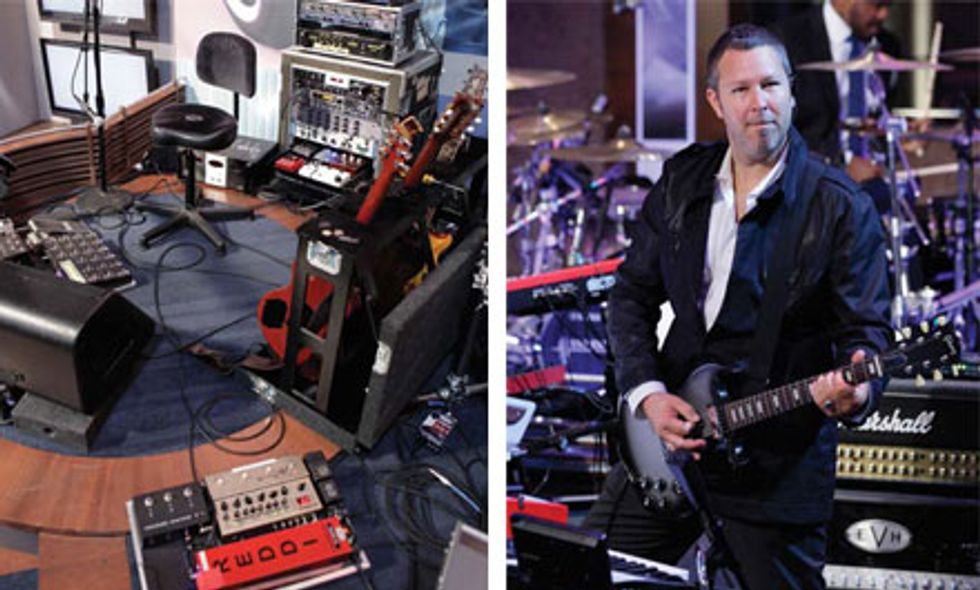
Follow the Leader
Long before that red light on the front
of the cameras turns on, an incredible
amount of preparation goes into each
show. Most of that falls on the shoulders
of the musical director, who is in charge
of choosing and arranging the material
the band plays each night. Given that the
bands typically play between five and eight
songs a night, the catalog builds very quickly.
“We are close to a thousand songs and I
have been here two years,” says The Tonight
Show bassist and musical director Rickey
Minor. “We try to add new songs all the
time, and not necessarily new songs on the
charts, but new songs period. Everything
from Blink-182 to Sinatra.”
With so many songs, it’s important for the musical director to be organized and have a great support team—which is usually anchored by a musical supervisor. Diane Louie has filled that role for Minor since 1987. “She has every chart that I have done or has been associated with my productions since ’87. And this was before computers, so we have transferred and scanned charts and scores,” he says. “Let’s say I want ‘I Will Always Love You,’ there might be nine different versions I have done—different keys, different arrangements, different orchestrations— everything from a symphony to a jazz trio. We have all the songs by title and date, with clips of the audio from it. It’s pretty sophisticated.”
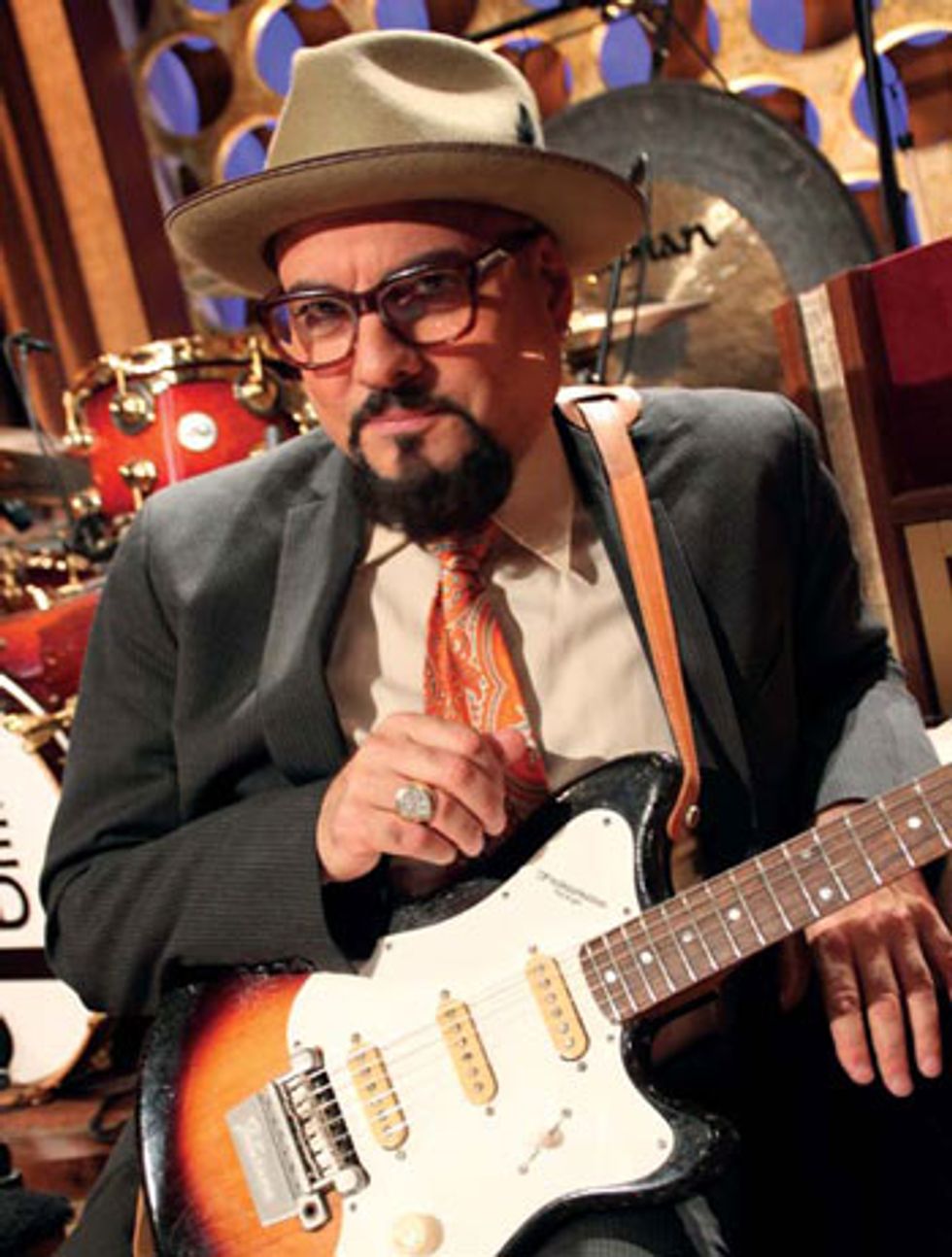
Conan’s Jimmy Vivino has a vast collection of guitars to choose from. Here, he’s pictured with a vintage Graziano/Futurama that has had the accordion switches removed and the pickups replaced with three pickups from one of Hound Dog Taylor’s original Norma guitars.
On Conan, musical director Vivino meets with Barre Duryea—who doubles as Vivino’s guitar tech and recording engineer— to decide not only what guitars will be used that day, but also what needs to be pre-recorded. “All of my job is about writing and arranging. Playing is a perk,” says Vivino. Although O’Brien himself is a huge guitar nerd, Vivino says he doesn’t get too involved when it comes to choosing the set lists. “I just put it together based on energy and flow for the show. The host doesn’t have any input other than trusting us.”
For Minor, supervising everything is the hardest part of the gig. “The most challenging part is managing personalities and just letting it go. This is true on any gig, but managing people and knowing when to step in and when to let people work it out themselves is important.” For Vivino, the ability to change direction with little or no notice to him or the band is a huge factor. “There are a lot of last-minute changes and additions to the work schedule every day. You have to be able to scramble at the drop of a hat,” he says. “What you don’t use today, you will probably need tomorrow.”
The Late Show’s Sid McGinnis (left), Will Lee (middle), and Felicia Collins (right). McGinnis’ go-to is a 1955
Stratocaster (pictured) that has been modifi ed with with different capacitors and resistors, rewired tone
controls, and rewound pickups. Lee primarily plays his Sadowsky Will Lee Signature model, and Collins is
pictured with her Hamer Daytona. Photo by Jeffrey R. Staab/CBS
Peaks and Valleys
Like any job, there are upsides and downsides
to playing to millions of people every night.
For most of the musicians in the late-night
bands, the chance to have a steady gig and
play with great musicians is definitely a
plus, but it also comes with a packed schedule
that often requires not seizing other
opportunities that come up unless they
occur between the six to eight weeks that
most late-night players get off each year.
When Lee first joined Letterman in the ’80s, he struggled to maintain his studio career due to the fact that most producers thought he was no longer available for outside sessions. “I ended up not doing a lot of records as a result of, y’know, being thought of as the guy who’s gotta leave,” remembers Lee. “Only certain producers, like the late Arif Mardin, would work around my schedule. However, that was a short-term problem because, in the long run, the [big-label] studio thing went away.”
Minor made similar sacrifices when he took his TV gig. “I had a couple of calls to do stuff on Broadway and write and conduct, and I can’t really take those jobs,” he says. “I have produced four different events at the White House with President Obama. If they don’t coincide with my weeks off, I can’t do them.”
Fallon bassist Mark
Kelley (left) and guitarist
“Captain” Kirk Douglas
(right). Though he primarily
plays Les Pauls with
the Roots, one of Douglas’
main guitars for the
show is this red Gibson
Custom Shop ES-356. Douglas and Kelley’s setups,
like most late night
shows, are optimized for
the small studios and
low stage volume. Kelley
uses an Ampeg Micro-VR
(back) and Douglas uses
a Mesa/Boogie Stiletto
combo (front). Photos by
Lloyd Bishop/NBC.
For a band like the Roots—which was known for its incessant touring before it landed the TV gig—the time commitment means they now have to go out on the road in shorter spurts. But they actually see that as a welcome advantage. “When we do go back out on the road, for like the first day or the second day, you’re, like, ‘Oh, this is great,’” says Douglas. “By the third day I am reminded why I don’t like touring anymore. I get a quick reminder of how fortunate we are in that realm.”
For a show like SNL, which has a shorter but intense yearly schedule, the hours can be the tougher part. “Since we are there from about 10:30 a.m. until 1 a.m. on Saturdays, it really feels like an entire week rolled into one day,” says Scharff. However, even with the long hours, Scharff says it’s worth it just because he gets to interact with some of his biggest musical heroes. “Aside from playing with the sickest band ever, it’s great to see amazing bands play on the show. And sometimes, like last season’s finale with Mick Jagger and Jeff Beck, we get to play with them.”
On top of the longer-term commitment, for about 40 weeks per year—fewer for Saturday Night Live, which is seasonal— missing even a single show isn’t really an option. “There was one time when I was so sick and felt like my body was exploding and [band leader] Lenny Pickett was, like, ‘You should do the show,’” laughs Scharff. “I made it happen. I have never missed a show.”
Although these strict short- and longterm scheduling considerations are challenging for all the players we spoke to, they only underscored the need for each of them to find ways to exercise their own creative muscles outside those confines. All of the late-night bassists and guitarists interviewed here have one or more outside projects to keep the creative juices flowing in ways that TV-show playing isn’t conducive to. “If I suck or if I play my ass off, the [studio audience] reaction is always the same,” says Lee. “That’s why I’ve gotta go out and get my ass kicked by real music audiences.”
Kimmel bassist Jimmy Earl’s (left) go-to basses are a 1966 Fender Jazz with a Badass bridge and
Hipshot tuners with a Bass Xtender, and his new Warwick Jimmy Earl Signature bass. Guitarist
Toshi Yanagi (middle) recently purchased this 1964 Gibson Firebird I which he uses for the show’s
more rocking numbers. Yanagi’s arsenal (right) consists of a Gibson Flying V, Taylor acoustic, Gibson
Les Paul goldtop, Gibson Angus Young SG, and the Firebird. Photos by Jason Shadrick.
The Gear World
Although many of the players on late-night
TV are certified gearheads—just watch
Scharff geek-out on boutique pedals or
McGinnis talk DIY Tele wiring in our Rig
Rundown videos on the next pages—gear concerns tend to take a backseat to just
getting the job done.
Douglas from the Roots sums it all up nicely. “There’s so much going on with the skits that we’re involved in and the music that has to be learned for the day, when it gets to that point you realize that the gear … of course it has to be at a certain level of quality—but beyond that, it’s more about focusing on what has to be done. And the gear can kind of be secondary. It’s just got to work.”
Merritt from Conan takes the same practical approach to his bass rig, “Since I’m playing 99 percent of the time when the band is on, there’s no time to change instruments to tailor the sound for a particular tune. [And] switching instruments sometimes involves having to change output level—and when you go direct like I do, there’s no time for the audio crew to adjust levels for house, monitors, and on-air.”
Most of the guitarists we spoke to tailor their rigs to the songs they’ll be playing on any given night, with some special consideration being given to versatility and the television audience. Yanagi prefers a clean amp with strong mids so he can “cut through those little TV speakers in homes” and stay out of the way of the other instruments. Late Show guitarists have to be prepared for whatever tunes might be called up. Collins explains, “Each night, I’ll have a single-coil [guitar], a guitar with humbuckers, [one with] P-90s, an electric semi-hollowbody … 6- and 12-string acoustics. Since practically every song we do happens from calling an audible, my gear is personal preference that I hope will accommodate a wide range of specifics.”
Vivino, on the other hand, takes particular joy in showcasing his many unique guitars and instruments from lesser-known luthiers. “Barre Duryea just throws five guitars out there for me and we make them work, depending upon what guitars we want seen,” he explains. “I guess after 20 years a lot of people tune in to say, ‘What’s Vivino playing today?’”
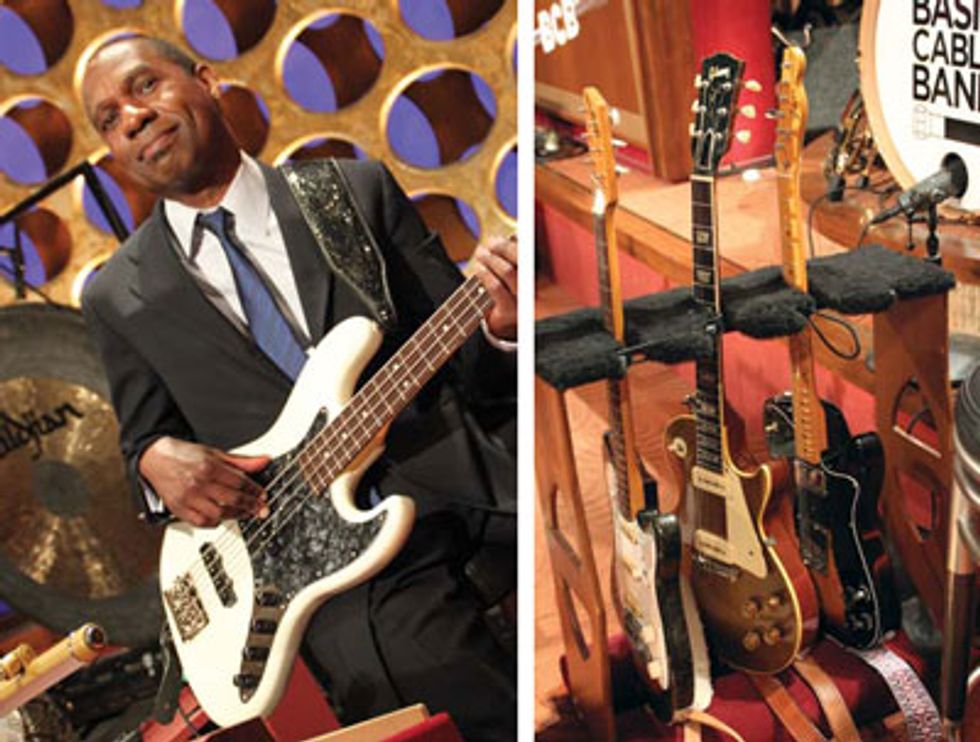
Breaking In
If your main reason for reading about these
players from late-night TV to see how
you can follow in their footsteps, you may
want to pause before giving notice to your
landlord and boss. There are cool opportunities
out there, but the prospects are about
as realistically bankable as setting off to
become a chart-topping rock star.
“These gigs are a dying breed,” says Scharff—the only guitarist we interviewed who got his TV gig through a traditional audition. There’s not a lot of turnover in late-night bands, as evidenced by the fact that most of the current groups have been with their shows since the inception.
That said, there’s always hope for passionate, skilled, dedicated players. Merritt sums up what many of the guitarists told us: “Be versatile, open, knowledgeable and respectful of all kinds of music. Approach playing songs like a good character actor plays a part. Be a quick study, learn things fast, be a good reader, be prepared, and be in the moment.”
But it’s about more than just being a badass on bass or guitar. All the players we spoke to emphasized the importance of personality and being able to work well with others. “If you are someone who is fun to be around and is responsible enough to do what it takes, then you will gravitate to like folk,” says The Tonight Show’s Delhomme.
Letterman’s Lee sums up what’s at the heart of it all, though. Follow his advice, and the aforementioned obstacles should all be secondary. “Love what you do—that’s the No. 1 priority.”
Late Night Gear, part 1
The Tonight Show with Jay Leno
NBC, nightly 11:30 p.m. EST
THE PLAYERS Rickey Minor (bass), Paul Jackson Jr. (guitar), Dave Delhomme (guitar)
YEARS ON THE GIG Two. Prior to joining The Tonight Show in 2010, the band worked together on American Idol for five seasons.
GEAR
Rickey Minor: Three Sadowsky J-style, one P-style, and one 5-string, Ken Smith 4-, 5-, and 6-strings, ’68 Gretsch 6071, A-Designs REDDI tube DI, Boss FV-500, and Lehle 3@1.
Paul Jackson Jr.: PRS SC 250 with 245 pickups, PRS JA-15, custom PRS baritone, Takamine acoustics, Veillette Gryphon, Fuchs ODS-100, Evil Robot, Kasha RM100H Rockmod, CAE 3+ SE, Fractal Audio MFC-101, Xotic BB Preamp, AC Booster, and RC Booster, MXR Dyna Comp, Bass Compressor, and CAE MC-402, Visual Sound Jekyll & Hyde, Hartman Analog Flanger, Fulltone Deja’Vibe, Tanabe Zenkudo, XTS Atomic Overdrive, Strymon El Capistan, Yamaha AG Stomp, Dunlop Cry Baby, Boss FV-500, and Boss TU-2.
Dave Delhomme: Custom PRS solidbody and semi-hollow with piezo and stereo outputs, PRS 305, Line 6 JTV-59, EVH 5150III, Palmer PDI-03, Joe Meek floorQ, Demeter Compulator, Dunlop EVH95 wah, MXR EVH Phase 90, MXR Carbon Copy Analog Delay, Planet Waves Chromatic Tuner, Line 6 POD HD500.
Conan
TBS, Mon–Thurs 11 p.m. EST
THE PLAYERS Jimmy Vivino (guitar),
Mike Merritt (bass)
YEARS ON THE GIG Nineteen. Both Vivino
and Merritt were members of the band that
premiered with O’Brien when he started Late
Night with Conan O’Brien on NBC in 1993
GEAR
Jimmy Vivino: 1953 Gibson Les
Paul goldtop, Gibson Super 400 CES, Fender
American Vintage ’72 Telecaster Custom,
vintage Grazioso/Futurama (modified), and
a vast collection of 100+ guitars. Vox AC15
Hand-Wired, Fender Eric Clapton Twinolux,
Visual Sound Visual Volume, Visual Sound Dual
Tap Delay, Visual Sound Double Trouble, Visual
Sound Angry Fuzz, Visual Sound Liquid Chorus,
Fulltone Supa-Trem, and Dunlop Cry Baby.
Mike Merritt: Sadowsky Vintage 4 (with
Hipshot Xtender), Aguilar DB 750, ported
Aguilar DB 115 cab, Aguilar Agro, Aguilar
Octamizer, Aguilar Filter Twin, and Boss TU-2.
Jimmy Kimmel Live!
ABC, nightly 12 a.m. EST
THE PLAYERS Toshi Yanagi (guitar),
Jimmy Earl (bass)
YEARS ON THE GIG Nine. Yanagi and Earl
were in the original band that launched with
the show in 2003.
GEAR
Toshi Yanagi: Gibson USA Flying V
with Burstbuckers, Gibson Les Paul goldtop,
Gibson Angus Young SG, 1964 Gibson Firebird
I, Taylor acoustics, Morgan Amps AC20, PRS
50-watt, 2-channel “H” amp, Star Amplifiers
cab (with Celestion Golds), Morgan cab (with
Celestion Greenbacks), Keeley-modded Line
6 DL4, Line 6 MM4, Xotic BB Plus, Xotic EP
Booster, Fulltone OCD, Lovepedal COT 50,
Fulltone Ultimate Octave prototype, Z.Vex
Distortron, Vox wah, and DigiTech Whammy II.
Jimmy Earl: 1966 Fender Jazz bass (with
Badass bridge and Hipshot Bass Xtender),
Warwick Jimmy Earl Signature, Gallien
Krueger 800RB, Ampeg SVT 4x10 cab, custom
high-end cabinet made by Steve W. Rabe (of
SWR fame) that’s stocked with only tweeters.
Late Night Gear, part 2
Saturday Night Live
NBC, Saturdays 11:30 p.m. EST
THE PLAYERS Jared Scharff (guitar)
YEARS ON THE GIG Six
GEAR Fano Alt de Facto JM6, Fano
Fanosphear, KLH Custom Relics T-style,
65Amps Monterey, 65Amps Soho, 65Amps
Lil’ Elvis 1x12 (in isolation cab), Boss TU-2,
custom Real McCoy Picture Wah, Keeleymodded
Ibanez TS9, Home Brew Electronics
UFO, JHS Mini Bomb Boost, Earthquaker
Devices Disaster Transport, Boss DD-5, Sweet
Sound Ultra Vibe, Cusack Tap-a-Whirl, Analog
Man Mini-Chorus, and Xotic BB Preamp.
The Late Show with David Letterman
CBS, nightly 11:30 p.m. EST
THE PLAYERS Will Lee (bass), Sid McGinnis
(guitar), Felicia Collins (guitar)
YEARS ON THE GIG Lee started 30 years ago
with the show’s 1982 pilot on NBC, 28 years
for McGinnis, and 19 years for Collins, who
joined in 1993 when the show moved to CBS.
GEAR
Will Lee: Sadowsky Will Lee Signature
and Vintage 5, Line 6 Variax Bass 700, ‘60s Vox
MK IV bass, Fender American Standard P bass,
Hofner Club bass, Hartke LH1000, Hartke 4x10,
Radial JDI, and Boss GT-10B.
Sid McGinnis: 1955 Strat (refin, modded),
1954 Strat, two ’50s “partscaster” Teles, ’96
Fender Nocaster Relic, ’52 Gibson Les Paul
goldtop (refin, moded), Danelectro Vinnie Bell
Coral Electric Sitar, Danelectro 12-string, 1963
Fender Showman (Bill Krinard Dumble-style circuit),
Vox wah, Boss NS-2, Boss PSM-5, Ibanez
TS9, Boss DS-1 (Analog Man mod), Boss BF-2,
Boss DD-3, and Demeter Tremulator.
Felicia Collins: Hamer Model T, two Gibson Les
Pauls, Taylor 812ce, custom Alvarez acoustics,
Hamer DuoTone, Crate Power Block, DV Mark
Little 40 L34, DigiTech Whammy, TC Electronic
PolyTune, Boss NS-2, Boss PW-10 V-Wah,
Death by Audio Interstellar Overdriver Deluxe,
Visual Sound H2O, Boss DD-5, DOD FX35,
Voodoo Lab Micro Vibe, and DigiTech RP500.
Late Night with Jimmy Fallon
NBC, nightly 12:37 a.m. EST
THE PLAYERS Kirk Douglas (guitar),
Mark Kelley (bass)
YEARS ON THE GIG Three for Douglas, who
was an existing member of the Roots when they
were chosen as the house band for the show’s
2009 premiere. Kelley joined the band in 2012.
GEAR
Kirk Douglas: Gibson Custom Shop
ES-356, Gibson Custom Shop Les Paul
Pro (with Lollar P-90s), Gibson Custom
Shop Byrdland (strung with flatwounds),
1969 Gibson SG Custom, 1961 Epiphone
Crestwood, 1969 Gibson Hummingbird (with
Fishman pickup), Mesa/Boogie Stiletto,
Electro-Harmonix Deluxe Electric Mistress,
Empress Tremolo, Maxon Phase Tone, Line 6
DL4, MI Audio Crunch Box, Durham Electronix
Sex Drive, Dunlop Jimi Hendrix Cry Baby,
Ibanez TS9, and Boss TU-2.
Mark Kelley: Fodera Emperor 5-string, 1964
Harmony bass, Peavey 4-string, Ampeg
Micro-VR, Native Instruments Guitar Rig.


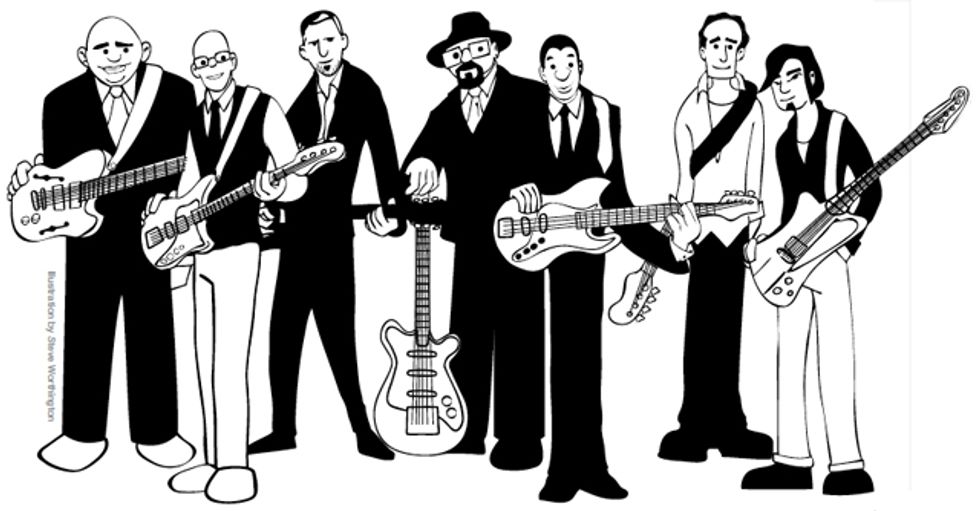
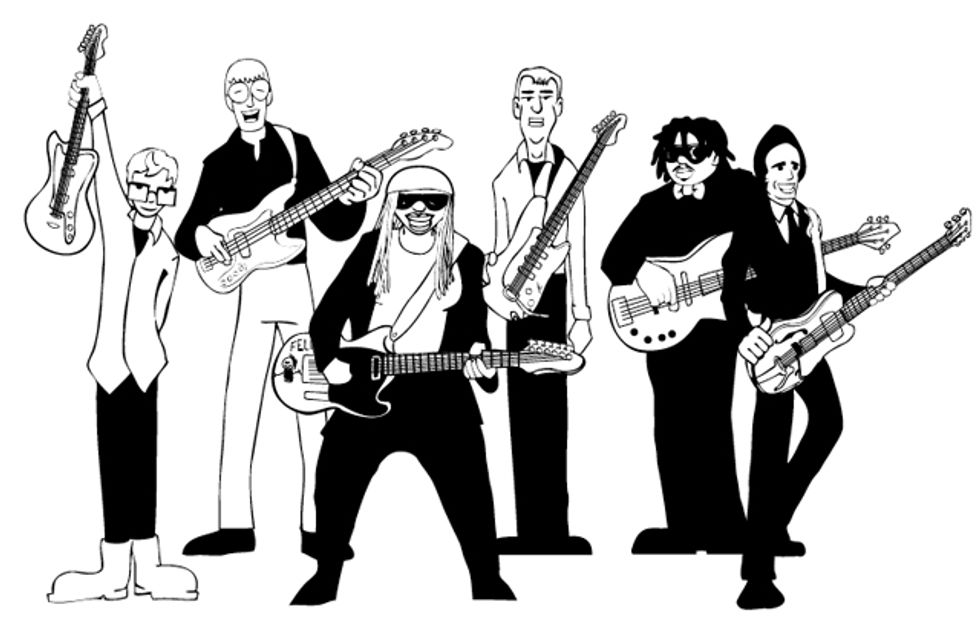
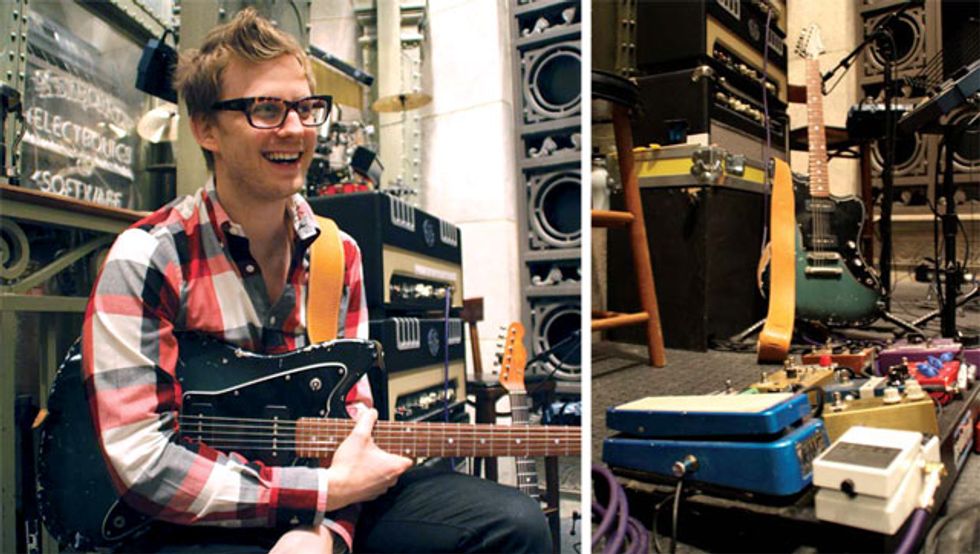
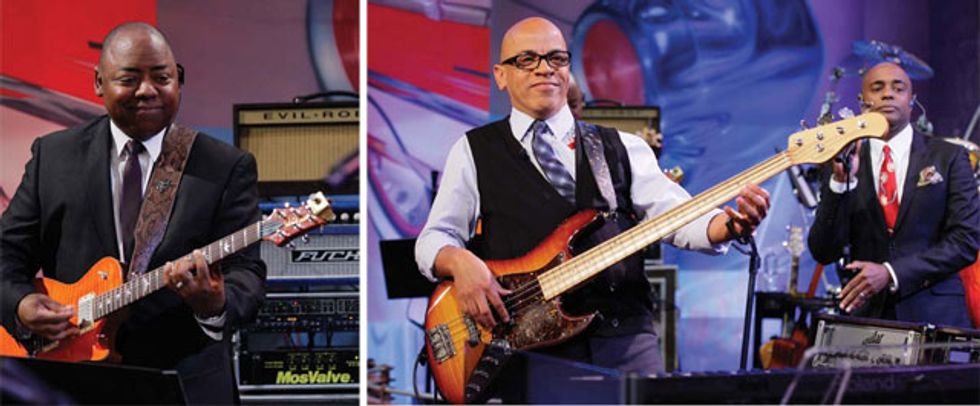
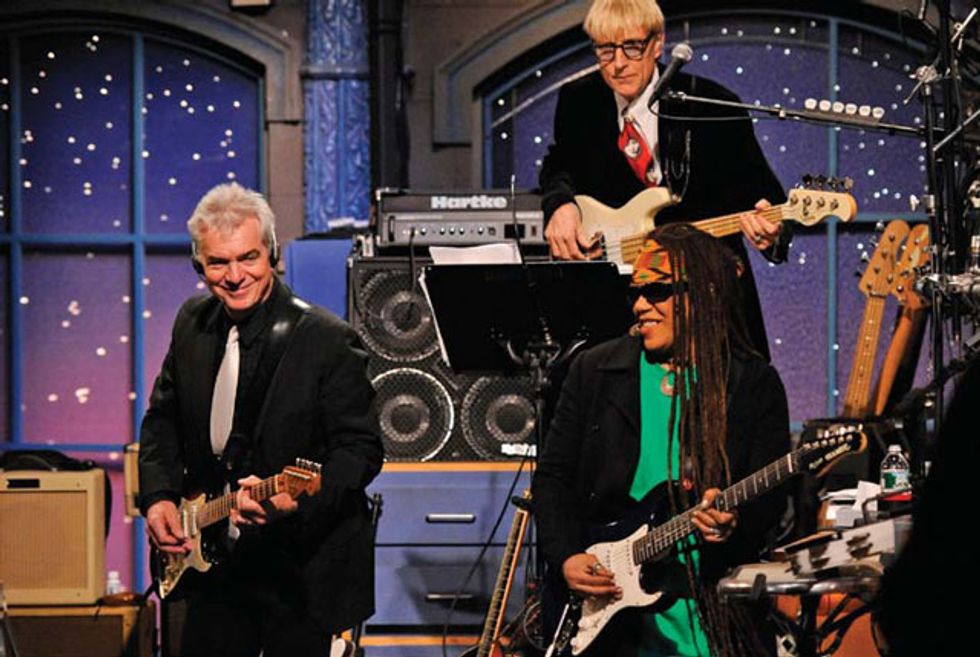
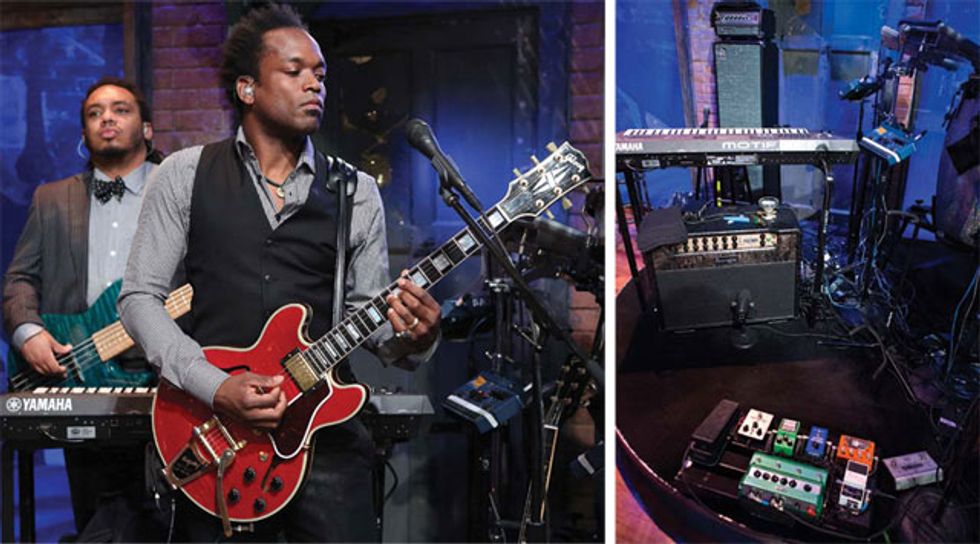
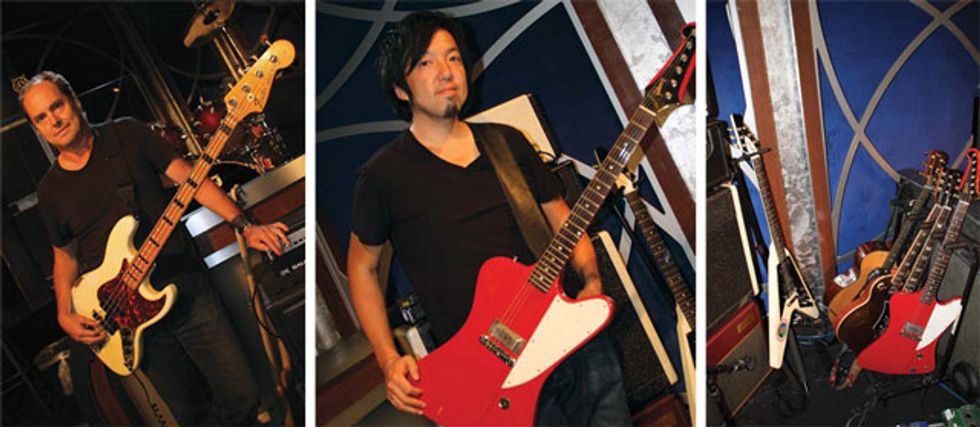








![Rig Rundown: Russian Circles’ Mike Sullivan [2025]](https://www.premierguitar.com/media-library/youtube.jpg?id=62303631&width=1245&height=700&quality=70&coordinates=0%2C0%2C0%2C0)












![Rig Rundown: AFI [2025]](https://www.premierguitar.com/media-library/youtube.jpg?id=62064741&width=1245&height=700&quality=70&coordinates=0%2C0%2C0%2C0)




















 Zach loves his Sovtek Mig 60 head, which he plays through a cab he built himself at a pipe-organ shop in Denver. Every glue joint is lined with thin leather for maximum air tightness, and it’s stocked with Celestion G12M Greenback speakers.
Zach loves his Sovtek Mig 60 head, which he plays through a cab he built himself at a pipe-organ shop in Denver. Every glue joint is lined with thin leather for maximum air tightness, and it’s stocked with Celestion G12M Greenback speakers.











